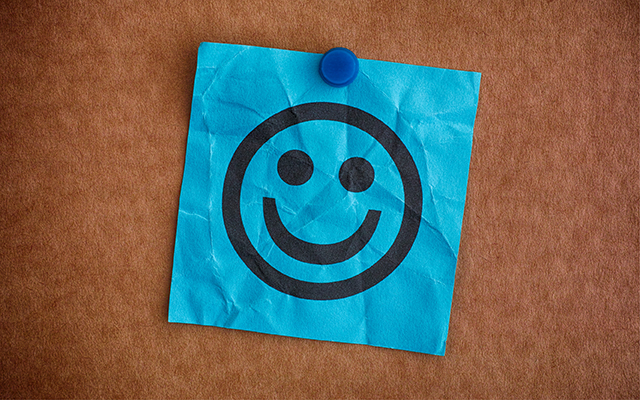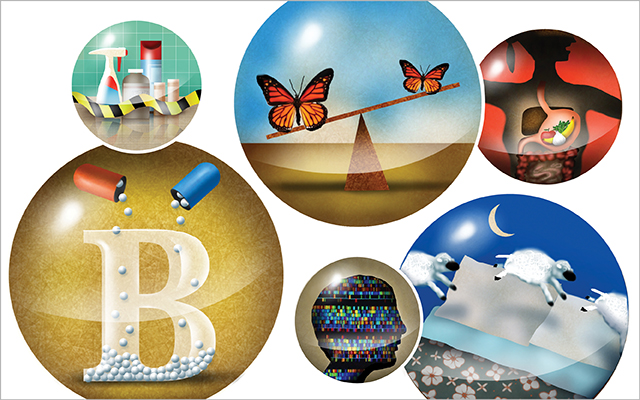Robert Smith found happiness in the most unlikely of places: a federal prison.
As a 26-year-old serving a nine-month sentence for credit-card fraud, Smith was perusing the contents of a mobile bookshelf on his first day behind bars when he came across a book about happiness — specifically, the happiness of a prisoner who learned to find good in every bad situation. The book’s message hit home for him. “The author said to give thanks for everything,” Smith says, “and from that day on, I gave thanks for being in prison, and I made my mind up to make the most of every day behind bars.”
Smith set some goals. He lost 30 pounds. He studied marketing and public relations in hopes of opening his own business. He befriended an inmate who became something of a spiritual mentor to him. And he wrote long letters to his family.
Today, the 30-year-old entrepreneur firmly believes that happiness is a choice — an outlook that has nothing to do with things like money or possessions. “I count my blessings, I work hard, I care about people and I give my best,” he says. “This formula has made me happy beyond measure.” Researchers who study happiness say Smith has precisely the right idea.
Proof Positive
While happy moments might happen of their own accord, a large body of psychological research suggests that a state of lasting happiness is something that must be practiced daily.
But can people really choose to be happy and actively develop a state of happiness like they might a state of physical fitness? For those suffering from serious mental illnesses, it’s not so simple, of course.
But for most of us, the answer seems to be yes.
Research from a relatively new field of study called positive psychology shows that it is possible to actively raise your level of happiness. In fact, the concept of “cultivating” happiness may be the secret to health, a meaningful life and lasting satisfaction.
Martin E. P. Seligman, PhD, an author and professor at the University of Pennsylvania, is considered the father of positive psychology. He describes the field as a change in psychology’s focus: Rather than studying the negative side of the psyche, like mental illness, it examines positive emotion and mental health.
Scientifically speaking, happiness is a tricky thing to measure, or even define. Is happiness a series of good moments — influenced and increased by a new lipstick or a great workout? Or is real happiness enduring — a general sense of well-being?
For Seligman, happiness has three domains: pleasure, engagement and meaning. “The key to thinking about your level of happiness is to see that it is not just pleasure, but also a life of engagement and a life of meaning,” he says.
Our experiences of pleasure, whether in the form of a backrub or a new car, tend to have set limits. (Seligman notes that lottery winners and paraplegics both tend to return to their previous level of happiness or grumpiness one year following their life-changing event.)
We also tend to adapt to pleasure: If you get a backrub every day, it ultimately feels less like a treat and more like a right. Engagement is more malleable; it involves being absorbed in your work and relationships with friends and family. Creating meaning requires getting out of your own head and using your strengths and virtues to get involved in something bigger than you are.
When it comes to happiness, the domains of meaning and engagement are more important, and more easily enhanced, than pleasure. Still, positive psychology says that we can master all three, and by doing so, live happier, more fulfilling lives.
It all sounds enticing, but also a bit daunting, this idea that we control our own happiness. What excuse do we have, then, if our lives are not what we want them to be? If Seligman is right, the most accurate excuse might be our lack of practice.
Practice Happiness
Because mastering anything takes work (and, often, a little help from an expert), Seligman launched a web site, www.reflectivehappiness.com, to help average people develop the attitudes, skills and habits most likely to predispose them to a happier life.
The exercises on the Web site are drawn from an undergraduate positive-psychology class Seligman taught, as well as a six-month course called Authentic Happiness Coaching. His students’ experiences gave him the data he needed to assert that happiness, like a muscle, can be increased by exercise.
“My students were saying these exercises were life changing,” he says. “I began to see they were much happier [after doing the exercises].” Further testing, and using placebos and control groups, convinced him that the exercises he developed could help a wide range of people increase their happiness and decrease their depression.
Seligman’s happiness-building exercises have expectedly New Agey names like “Three Blessings,” “The Gratitude Visit” and “Savor a Beautiful Day.” (For details, see below.) One foundational exercise involves finding what Seligman calls our “signature strengths”: those strengths and virtues that are individually important to us. (The 24 strengths identified by Seligman range from things like “love of learning” to “mercy.”)
Sharon Albert, 56, a doctorate of psychology student in Harpers Ferry, W. Va., was struggling with a difficult perimenopause and uncontrollable mood swings when she signed up for Seligman’s Authentic Happiness Coaching course. She says discovering her signature strengths, which included love of learning, creativity, kindness, gratitude, and appreciation of beauty and excellence, changed her life: “There’s no medicine that can do for you emotionally what building your life around your signature strengths can do.”
Practicing other exercises, like Three Blessings and Savor a Beautiful Day, helped Albert manage the irritability and anxiety that had been making her feel so powerless. Practicing the savoring exercise, in particular, in which she planned and executed her version of a perfect day, has turned into a regular habit of enjoying life’s little pleasures.
“Before, I was really into quantity. Whatever it was, I’d just pile it away,” she says. “I love ice cream, for example, but since taking the class, instead of eating an entire pint I’ll just have a quarter cup. I never buy anything but the very best — Häagen Dazs — and I savor every bite. You can’t believe how much more you taste when you take a long time to experience something.” The exercise, she says, has taught her to be fully present with whatever she’s doing.
Now, she feels great. “Recently, I went to the reflective happiness Web site and took two tests to see where my baseline happiness is,” she says. “I came out pretty darn good, but I didn’t need a test to tell me that.”
Another Seligman student, Deb Giffen, 52, had a powerful experience with the Gratitude Visit. She focused the exercise, in which you write a thank-you letter to a living person who has influenced your life, on her father. She had some trepidation because her father, a tough executive, was “not an easy person to share emotion with.” But she wrote it and made plans to visit him at his home on Father’s Day. Instead, he ended up in a hospital after complications from a heart procedure. Giffen read her letter to him in the hospital; he died the next day.
“I’m just forever grateful that I had that chance,” she says. The exercise, which she continues to do by writing a new letter to her father each year, “dramatically showed me how important it is to communicate things like this.”
Going through the exercises, she says, makes people focus on the things that make them happy, and once they do that, synchronicity happens. “In my own life, as long as I stay focused on these exercises, life just goes better,” she says.
Better Health
Seligman himself has benefited from the exercises. A bona fide pessimist (in Authentic Happiness, he describes his former self as “a walking nimbus cloud in a household radiant with sunshine”), he’s taken his own advice and measurably increased his overall level of happiness. “Evidence is very good that you can lastingly change pessimism into a more optimistic stance,” he says.
There’s also good evidence that it’s in a pessimist’s best interest to change. According to Seligman, research shows that pessimists are two to eight times as susceptible to depression when they experience setbacks, do less well in the workplace than their cheerier colleagues and tend to have poorer physical health than optimists. Research even shows that happy people tend to live longer.
“Happiness is a major key to health,” agrees Peter Ubel, MD, a professor of medicine at the University of Michigan in Ann Arbor who is writing a book on emotional resilience. One reason is that conditions like stress, anxiety and depression negatively affect the body’s immune system, Ubel says: “If you’re chronically in a bad mood or anxious or stressed out, that really takes a physical toll. If you’re not happy, it’s a lot harder to stay healthy.”
So does it work the other way around: Do you need to be healthy to be happy? “Our research says no,” Ubel says. He and a team of researchers at the university recently studied dialysis patients and found surprising evidence that despite their chronic health problems, they were just as likely to be happy as those without major medical conditions. The study was published in the Journal of Experimental Psychology.
Of course, that’s not to say that health never affects mood, but the emotional effects of negative health “tend to be shorter-lived than any of us would expect,” Ubel says. In fact, adversity can be a real force for positive change. People facing major illness tend to focus on what’s important in their lives and brush aside little things that don’t matter.
For Ubel, that’s key. “I do think a big part of happiness comes down to focusing on important goals in life, whether it’s helping others or doing things you find intrinsically meaningful,” he says. Seligman would call that living a meaningful and engaged life. And if people faced with major hardships — whether physical ailments or situational circumstances — can make themselves happy, doesn’t that bode well for the rest of us?
Hone Your Happiness Skills
Three exercises for more happiness, from positive psychologist Martin E. P. Seligman:
Three Blessings. Every night for a week, before you go to bed, write down three things that went really well during your day. They can be relatively simple (“I worked out today”) or more substantial (“I ran my first marathon”). Next to each one, write why that good thing happened (“I turned off the TV and went to the gym”). The act of recording the good things in life is a concrete way to make positive thinking a regular part of your schedule and to recognize your own role in making good things happen.
The Gratitude Visit. Think of one person, still living, who made a big difference in your life but whom you never properly thanked. Write a 300-word, heartfelt testimony to that person, explaining how he or she touched your life and why he or she is meaningful to you. Then call and say you want to visit, without explaining why. At the visit, read the letter aloud. Gratitude is a powerful tool for increasing happiness, according to Seligman’s research, because it intensifies positive memories and forges bonds.
Savor a Beautiful Day. Pick a date within the next week or two to set aside at least a half day (or full day, if you can) in which you design your perfect day. Carry it out using “savoring” techniques, such as sharing it with another person, keeping souvenirs and losing killjoy thinking. Practicing the technique of savoring “intensifies and lengthens positive emotion,” Seligman says. “That makes for wonderful days and afterglows.” Continue to practice savoring in other ways in your life, like letting an exquisite piece of chocolate melt slowly in your mouth or taking time to close your eyes and listen to a beautiful piece of classical music.
Try a new happiness exercise each month; they’re available by subscribing to www.reflectivehappiness.com.




This Post Has 0 Comments